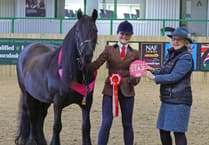Dartmoor Zoo has had a very special guest since last November. That is when Freddo, a rare nine-year-old Amur leopard, was shipped over from another facility in Belgium.
Freddo has reportedly settled well, despite having to acclimatise to Devon’s wet weather and adapt to living in a new enclosure.
However, Freddo’s stay in the South Hams has a particular significance as the zoo is hoping he will eventually breed.
Mating successfully is considered crucial for the species’ survival as there are believed to be only about 120 left in the wild and 220 in captivity, with the World Wildlife Fund (WWF) describing the Amur leopard as “critically endangered”.
In contrast to its African cousin, the Amur leopard has a far thicker coat that is more suited to the freezing cold temperatures that are found in its natural habitat, which is mostly limited to the far east of Russia and China.
Aside from its limited range, it is also threatened by habitat loss and poachers, despite being a protected species, so the Amur leopard is facing a very uncertain future.
Fortunately for Freddo, he is part of a breeding programme known as the Zoological Information Management System or ZIMS, which holds details in its extensive database of some two million animals from about 25,000 different species.
Speaking to the BBC recently, Benjamin Mee, the chief executive officer at the Dartmoor Zoological Society, said he had been trying for the past seven years to bring Freddo to the zoo.
“This is the world's rarest big cat which is why the re-introduction is so important,” said Mr Mee, who described the ZIMS programme as an “animal dating site”.
To illustrate the importance of finding Freddo a successful mate, Dartmoor zoo is looking to build a dedicated enclosure just for a female leopard and may even consider a crowdfunding initiative to fund its construction.
Dartmoor Zoo marketing manager Emma Thomas however explained that finding a right match was not as easy as simply presenting Freddo with a female of the species.
“We’re still in the early stages of trying to find a suitable genetic match. It’s about making sure we create an entirely new line, so the specifics of the genetics have to be really thorough – we have to make sure that there hasn’t been a breeding of that pair before,” she told this paper.
Amur leopards can expect to live for up to 15 years in the wild, but in captivity they can survive five years longer, so there is still ample time to find him a loving mate.
According to the WWF, some males stay with females after mating and may help with rearing the young, so if Freddo is successful he will be kept busy.




Comments
This article has no comments yet. Be the first to leave a comment.